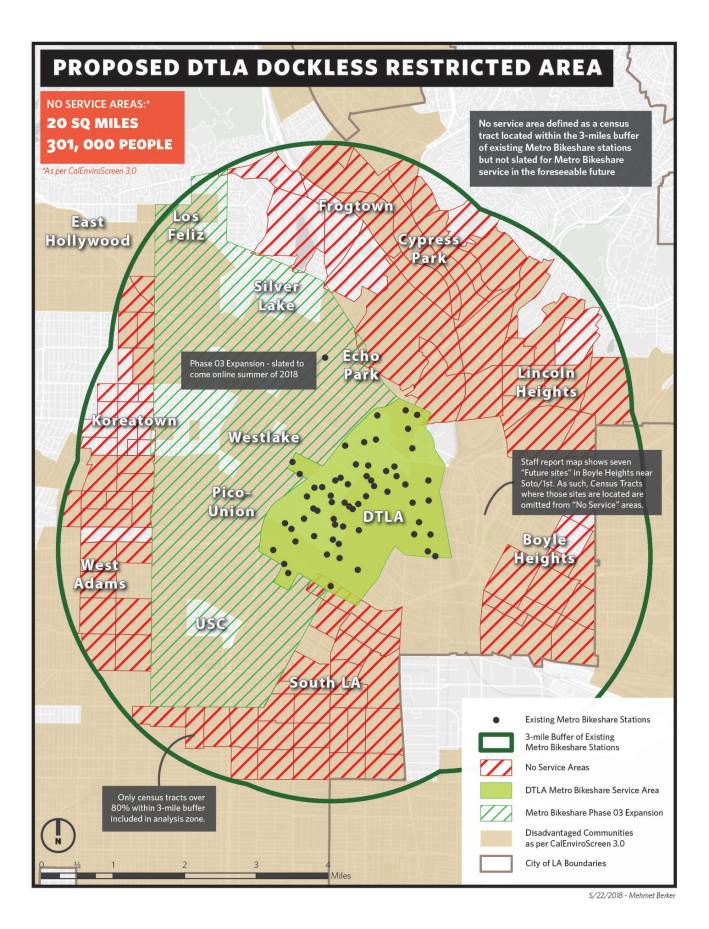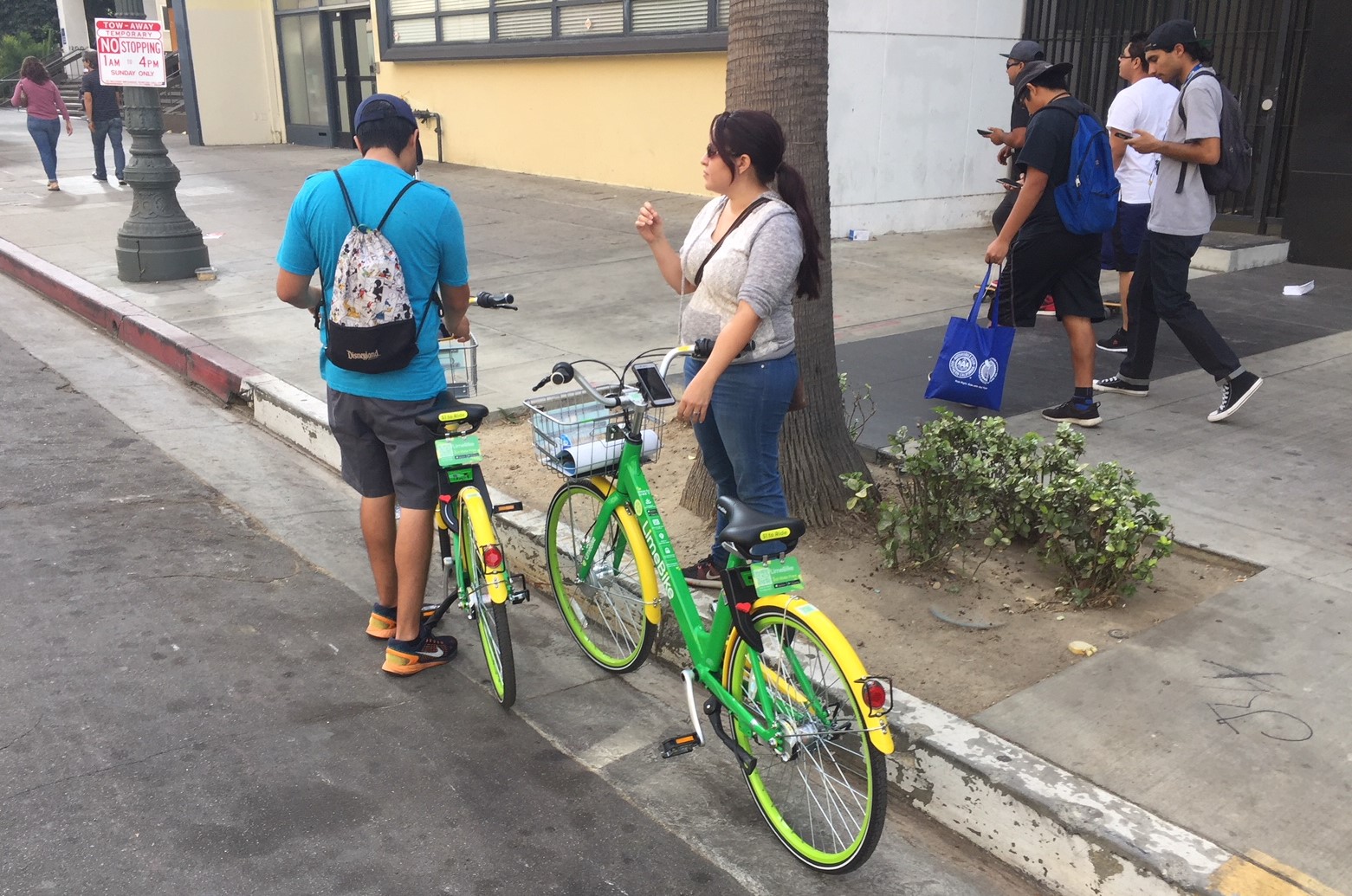This afternoon, the L.A. City Council Transportation Committee took action on three issues that Streetsblog readers may be interested in.
Dockless Bike Share
The most extensive discussion at T-Committee today was on the city's proposed docklesss bike-share (DoBi) regulations, which would apply to shared bikes, e-bikes, and scooters. There was extensive public input, including plenty of comments from folks representing various bike-share and scooter companies.

Ultimately the proposal was continued - basically postponed for about a month - with directions to LADOT to make some modifications:
- Reduce/Eliminate Boundary Restrictions: The proposal calls for a 3-mile buffer that would keep DoBi away from existing Metro Bike Share areas. The buffer would effectively eliminate DoBi in the Harbor area and would restrict devices in a large portions of central and west Los Angeles.LADOT General Manager Seleta Reynolds confirmed that the "geofence" boundary is a political decision, not a requirement (as has apparently been the case in other jurisdictions based on exclusive municipal bike-share contracts.) Reynolds stated that, even though she doesn't imagine the fence will be in place forever, early fences could keep dockless devices out of downtown L.A., which she stated is where all the operators want to be. Reynolds emphasized using regulations - fences, fleet size limits - to incentivize good behavior. The committee directed LADOT to "get rid of the geofences" in a revised proposal.
- Increase Fleet Size Caps: The proposal called for an initial fleet of 500 bikes/scooters, which could increase by up to 250 each quarter to a maximum cap of 2,500. Similar to boundaries, Reynolds and LADOT Chief Sustainability Officer Marcel Porras justified the need for fleet caps to incentivize good behavior. LADOT has been in discussions with eight DoBi/scooter companies, so there is potential for the department to have to manage 40,000 shared mobility devices on city streets. The committee directed LADOT to bring back "different [presumably higher] recommendations for caps."
- Lock-To Mechanism: Most DoBi bikes just lock to themselves when not in use. In many places, from China to Dallas, this has resulted in bikes parked inappropriately, often blocking sidewalks and other public right-of-ways. One way to largely resolve this issue is for bikes to have a secondary "lock-to" lock that attaches to bike racks, etc. One DoBi company, Pace/Zagster, already includes lock-to features on its bikes. LADOT's proposal attempts to waffle on these secondary locks, requiring "a locking mechanism to lock to a fixed object" but further stating that this "requirement may be waived." The committee directed LADOT to remove the lock-to requirement, but have companies address concerns about devices blocking public rights-of-way.
- Equity: The proposed rules have several mechanisms to press DoBi to serve disadvantaged communities: cash payment option, reduced prices for low-income folks, and allowing bikes in equity communities to not count against fleet caps. The committee directed LADOT to also add equity incentives in the permitting price - currently $50 per bike/scooter anywhere. City Councilmember Mike Bonin suggested that the permitting price might be higher in his higher-income Westside district, and lower in Councilmember Nury Martinez's lower income San Fernando Valley neighborhoods.
The revised DoBi/scooter guidelines are expected to return to the Transportation Committee in late June. They are also expected to be heard in the Public Works Committee.
Parking Meter Revenue Local Return
The Transportation Committee approved a proposed one-year pilot program that would direct some parking meter revenues to improve the areas where they are collected. Parking expert Don Shoup has stressed that one key way to manage parking and to generate support for metering is to return parking meter revenue to the area where it is collected.
In late 2015, Councilmember Bonin proposed parking meter local return as part of a suite of far-reaching parking reforms.
LADOT is now recommending an initial pilot that would apply to parking meter zones in Lincoln Heights, Pacific Palisades, and Westwood. For the program, 15 percent of meter revenue would go to area Business Improvement Districts to make local improvements.
LADOT and the Transportation Committee are on-board with this meter local return, though it impacts the overall city budget, so it must also be approved by the council's Budget and Finance Committee.
Arts District Metro Station
The Transportation Committee also approved a motion to allocate $500,000 to fund Metro to do design and environmental clearance work for an Arts District Metro Station. The Arts District has been pushing for a station, and a current Metro Red/Purple Line yard project lays some groundwork for it, but the project currently is not funded.
The Arts District Station motion also goes to the council's Budget and Finance Committee.







